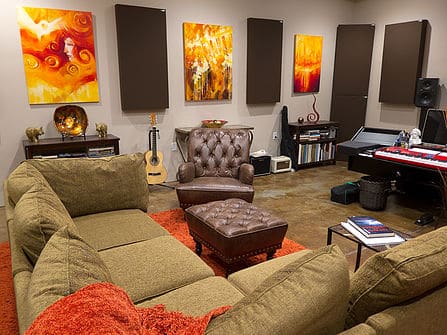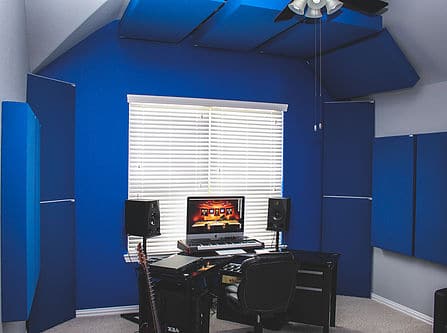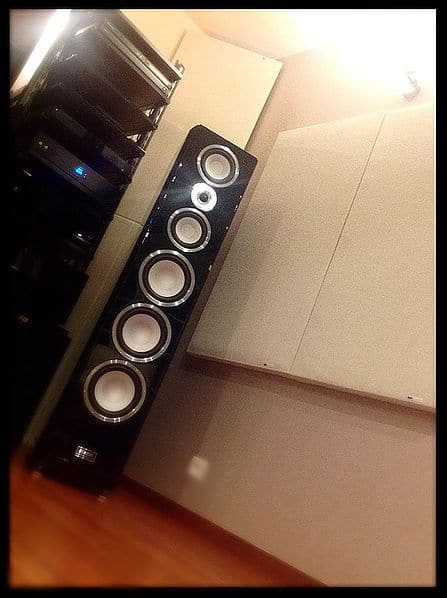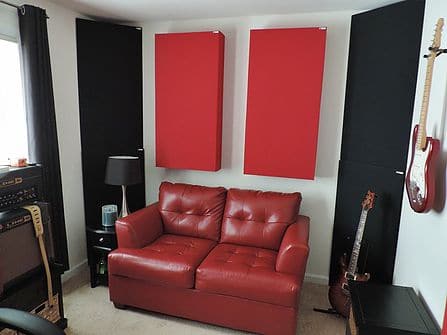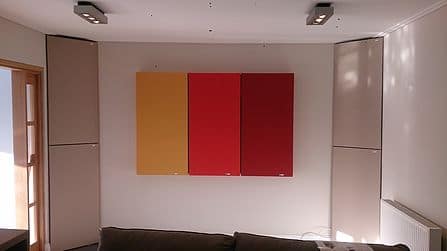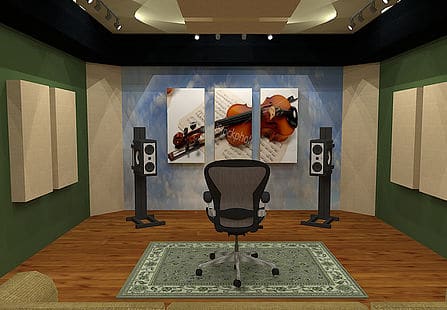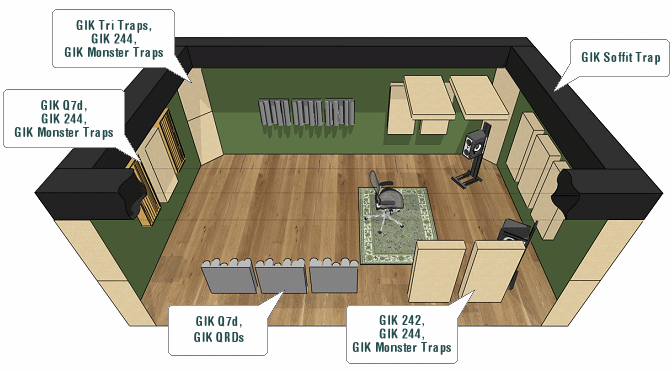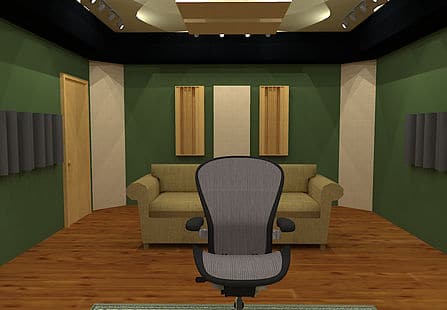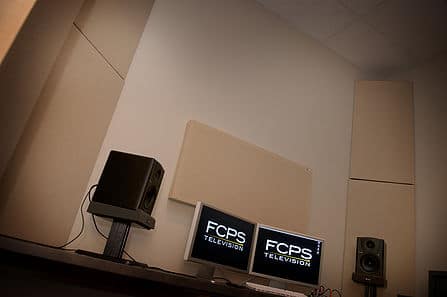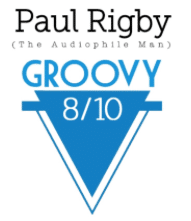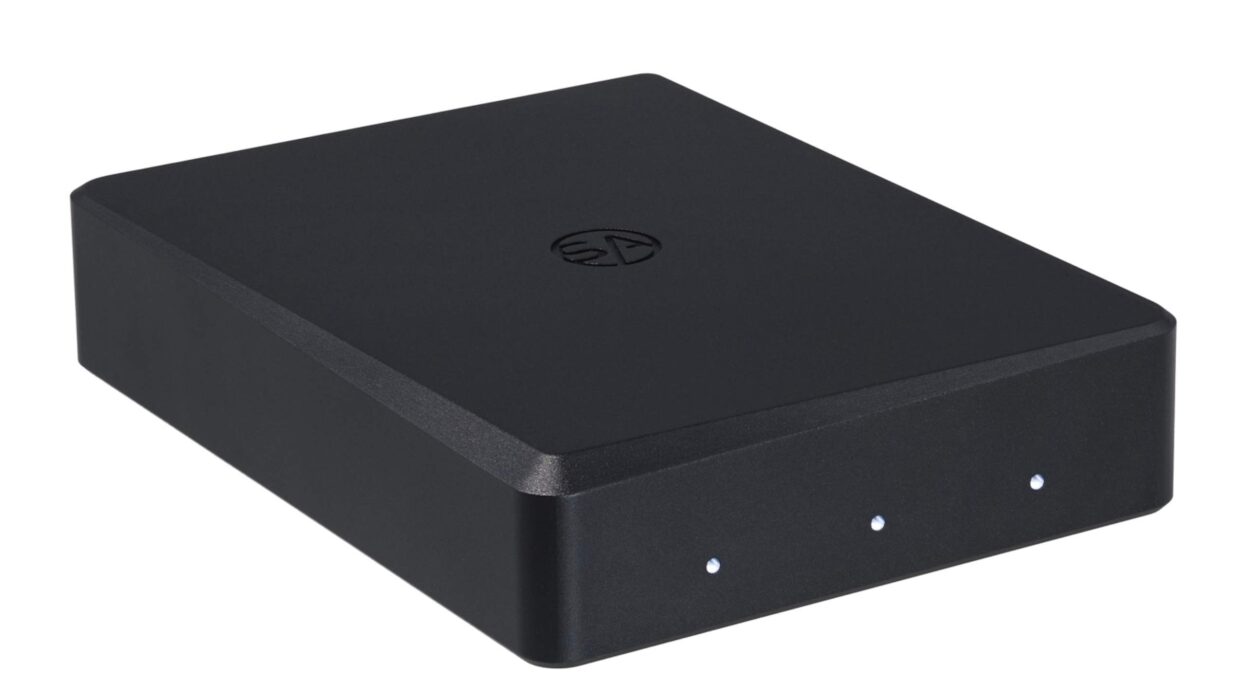The Article
GIK Acoustics sound traps: Absorb & Scatter
3rd January 2015
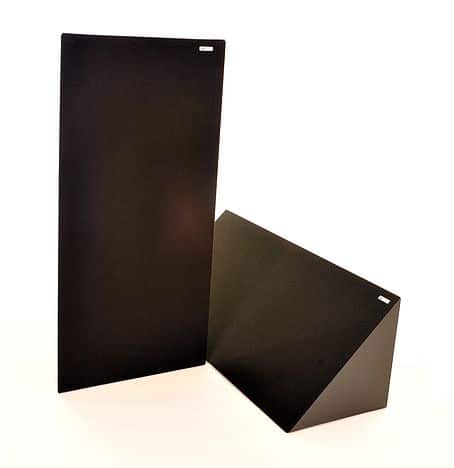
Do you think that your hi-fi system is solely responsible for delivering top sound quality? Think again. Paul Rigby reviews the GIK Acoustics sound traps
To improve the sound of a hi-fi, most people look to upgrade. That can be a new cartridge or arm on a turntable or the turntable itself or, indeed, the CD player or DAC. For their system, others might look further down the chain towards their amplifier. Some see the speakers as the culprit to a system that is not performing as expected. More enlightened users might try to address sonic issues by also investigating their ancillaries such as cables, shelving or isolation. This is all good and viable and worthy but it’s often the case that, no-matter what changes you make in the hi-fi chain itself, issues can still remain. What then? Well, it might be time to look around you. At your room.
Your room can cause all kinds of problems with sound quality, no matter what sort of hi-fi you own. These can range from boomy bass, no bass at all, screechy bright midrange and more. That’s right, a lot of these issues can be caused by the room. Not the hi-fi. The room.
Actually, there’s no need to wait until you’re at the end of your tether. There is a solid argument that says: before you even think about touching your hi-fi, get the room sorted first.
Rooms are odd things. They come in all shapes and sizes and are filled with weird and wonderful stuff. When thinking about hi-fi listening areas, you have to accept that every room is different and, of course, every set of ears is different and, to make it even harder, every hi-fi enthusiast is looking for different things from their music.
So what to do? How do you go about finding a solution to a problem as complex as that?
I asked GIK Acoustics that very question.
GIK Acoustics started in 2004 in the USA with GIK Acoustics Europe launched as a separate off-shoot. Both feature research and design offices (and both the US and UK offices are supported by University-based research facilities) with a sales office in Germany to add to the family. So who, exactly, is GIK?
“We are an acoustic treatment company, producing diffusers, panels, traps and so on,” said partner and General Manager, Dave Shevyn. “We originally come from the pro-audio world and thus bring a pro-audio solution to your home. The pro-audio market is still our biggest market, though. We’ve just finished work with Graham Stack who works with Take That and Kylie Minogue plus TMS who write the hits for Ellie Goulding and Emelie Sande. We’ve also recently worked with two software companies such as the people who create Grand Theft Auto. All of our products are tested to pro-audio standards too.”
GIK is interesting because it offers free acoustic advice and a lot of education resources are available, on tap. The advice part is one of the most important parts of the service and is presented on the company website via lots of documents and videos, “Also, if you go on the site, you can fill in a form, we ask you lots of questions and ask you to upload photographs of your listening room. If you’re a bit more advanced, you can even upload sound test files for your room. We can give you advice on the best way to tackle any found problems using acoustic materials. The advice isn’t just about selling products, it’s about getting the best sound out of the room so the first thing we always start with is to see how the room is set up.”
Shevyn is a strong advocate of this educative view because he also wants you to ‘unlearn’ certain hi-fi related ‘truths’ or, as he puts them, “myths”. For example, the placement of speakers. Most hi-fi experts say that you need to put Speaker X in this position and Speaker Y in that position. Shevyn rejects this notion, “It’s just not true. What happens is that most speakers suffer from SBIR (Speaker Boundary Interference Response). This is where the speaker responds to the boundaries all around them. We use that to our advantage. If you push the speakers against the wall, it’s still going to have interference form the wall but it changes the frequency that the inferences comes at. The best thing that we recommend is to experiment. It depends. There are NO rules.”
The most difficult premise that Shevyn is faced with (and one that does not exist in pro-audio) is that most people use their rooms in a variety of different ways, not just for listening to music via a hi-fi , “That’s why we do art panels where a flat acoustic panel can be presented as if it’ s a photograph or a painting. A family room is not a studio. The physicality of panels can be a source of friction between adults, we know, but we can change the look, size and colour and so on to help, they can be blended in or they can be coloured to really stand out. We can do a lot of customisation, unlike other companies.”
Talking about the pro-audio side of the business, the other difference between the pro audio and home hi-fi worlds is that, in pro audio, they are looking for a scientific correction of sound so that you don’t have more than 5db difference across all frequencies but, “When you listen to your own system at home it depends on what you enjoy and what you want to get our of the room,” said Shevyn. “Whenever any hifi enthusiast rings me, the first thing I ask is, ‘Why are you ringing me? What’s the problem? Too much bass? No bass? What’s the issue?’ Often, the issue is a new system which is exciting new sonic frequencies that were never excited before.”
So, GIK Acoustics has products that do specific things to the sound in your room. It offers absorption panels to soak up destructive bass frequencies, for example, diffusion panels that don’t absorb but scatter frequencies around the room or even an absorption panel with a diffuser built in, “You put it on the back wall,” said Shevyn. “A typical back wall produces low frequency echo problems, the diffuser helps to keep a nice even level at the midrange frequencies. So 50% of frequencies are absorbed and 50% are scattered.”
Diffusion helps to create an impression of a larger space because it breaks up the sound. In a home cinema, this effect is especially popular, “Sometimes people come to us with a wish list and we can help in many ways. We also have staff on hand who are familiar with different systems and know what each component is capable of.”
GIK offers a software program to help you test your room’s failings. You can download this from GIK direct, test your listening room and then post the results back to GIK who can then insert those results into their system to work out the problems you’re having. They then offer a set of solutions for that room.
This is all obviously very specific to you and your room but I did wonder if there are any general hints and tips that we can all think about? “Treat you first reflection point,” said Shevyn. “That’s the mirror point between where you are sat and where the speakers hit the wall, ceiling or floor. When the sound reflections hit the wall and then your ears, it basically confuses the stereo imaging. Milliseconds after you hear the direct sound you then hear reflected sound. So sounds you are hearing on the left, you should be hearing it on the right. Stopping the first reflection point means that you get the direct sound.”
Then there is the classic issue of echo. If you clap your hands in your room and you hear that echo, “This means that the high frequencies and mids are bouncing around the room,” said Shevyn. “Another popular issue is bass. Either too boomy or there isn’t any. For the latter, it might be the speaker positioning or the modes of the room. This means the dimensions of the room might be influencing the sound. For a lot of issues, we also recommend for you to actually walk around the room when the music is playing. Then you can hear many of room’s problems as you do this. Bass is omnidirectional so it will collect in corners, for example. Highs and mids are directional. This is why we have the education wing of the company. To teach people about this sort of thing.”
So how about furniture? Does this help? “Yes and no. Another myth is that a bookcase diffuses. It doesn’t. Diffusion has to be mathematically calculated to work properly. Bookcases don’t. Even if they do diffuse, they are uneven in how they do it. Soft furnishings help with absoption, though. What you have on the floor also makes a big difference. You’ll get reflections off a bare floor. Put a rug before the reflection point. You don’t need to fully carpet the room.”
Pieces of material on the wall won’t help the absorption factor, apparently. Shevyn said that a typical low E from your bass cone has an actual wavelength of 23 feet so a thin piece of material draped on your wall is not going to sort that monster out.
GIK’s products (well, the examples I tested) are light and easy to move around the room. They also feature a lot of woven rock (yes, that’s right, woven rock) which looks like candy floss, inside the panels, traps and so on, “We use something similar to Earth Wool but ours is eco-friendly because it comes with a different binding agent,” said Shevyn. “We also use Camira cloth, wood and MDF but I can’t tell you all my secrets!”
Instead of doing the ‘right thing’ and going through a systematic approach to perfect my own room, I asked for a batch of four corner traps and zero advice. Just to see if my cack-handed approach could improve the sound of my room. The idea of doing it this way was: if I can improve the sound quality of my hi-fi by stumbling and experimenting on my own with no help then, just imagine what improvements you can get if you do it the proper way. Or maybe it’s just that I’m impatient and the sort of guy who hates reading manuals and just likes to plunge in, head first. Not sure which.
SOUND TESTS
To begin the sound tests, I tried to place the traps into the classic areas of the room. As they were shaped with a corner-type chassis, you can’t blame me for trying to place them in the corners, can you? The problem with my listening room is that it’s dual purpose. Hence, behind one speaker are three book shelves with more furniture behind another, opposite that is a set of drawers and so on. So, my room really doesn’t have empty corners. For the review, this was a ‘good thing’. Not necessarily because of sound quality results but because most real life listening rooms will also not be empty with barren corners. Most listening rooms tend to fit in with the family or rest of your life, they a rarely the archetypical lonely empty space with a listening couch positioned at one end of the room and the hi-fi placed at the other end. Nevertheless, I tried my best to find ‘corners’ and played the prog instrumental, Genesis’ Los Endos that features plenty of complex low frequency noises and high pitched guitar from the genius of Steve Hackett.
In this formation, I must admit to being rather underwhelmed. OK, there was a slight improvement in the high frequencies and slight improvement in terms of controlling a few wayward notes but nothing of any great significance.
I decided to move things around a bit and took the two corner units from behind the speakers and, instead, placed them together, between the speakers, right in the stereo image sweet spot. Both units pointed diagonally forwards.
Playing the track again, the improvements were much greater. The lower frequencies were the star of the show here. This track has all kinds of percussive instruments doing their thing plus a bass guitar so there is plenty of bloom and leakage running from one sonic burst to the next. The GIK units tidied a lot of the mess up, frankly.
Hence, the bass guitar was far more focused and heard more as an individual instrument while each percussive part of the drums and secondary add-ons also ‘backed off’, found their own space and presented themselves individually. In this way, the track became much more interesting, giving the music richness and complexity instead of arriving as a low-end mush. The extra focus and clarity allowed the music to dance over the ear, making it lighter on its feet in a way that just wasn’t there before.
Moving the two units that were near to my listening position, at the back of the room to join the two units sitting now between the speakers just enhanced that new low frequency control. The upper mids and treble were hardly touched though so I tried to move the units around the room, like a 1:1 scale game of Tetris, trying unit positions while trying to prevent myself getting carried way, making pleasant looking patterns with them.
Then I had an idea. I use Quad ESL-57 electrostatics as my sound reference. These speakers are notorious for pushing as much sound out of the back of the speaker as out of the front so, I thought, why not place a unit behind each one? With a flat side of the panel pointing directly at the rear of each speaker? Bingo! That did the trick. Gone was any semblance of screechy upper midrange noise such as very high pitched guitar wailing, for example, which can become unstable and hurt the ears. The upper mids were now under control and, because of that, an extra focus was heard over the entire sonic spectrum allowing more detail to push forth.
CONCLUSION
The main lesson learnt here is two-fold. Firstly, yes the GIK units work. They definitely affect the sound of the music and in a good way. Secondly, there is no one answer for how they will work and if they will work for you and your listening room. This will be governed by your room shape, what you’ve already got in there and the type of system you use. So, if you want to know if they will work for you then the mantra will be: ’It depends’. In my case, I had to move the units around four or five times into wildly different positions before I found my own personal sweet spot (but then I didn’t benefit from GIK’s rather nice education advice service – I tried to be Mr Independent Journalist and wasted precious time because of it: don’t try this at home, kids). That said, once that sweet spot was found, it cleaned up any negative aspects of the music and improved the overall presentation giving me a vastly improved sound stage and greater clarity.
GIK ACOUSTIC PANELS TRI-TRAPS
Price: £238.80 per pair (traps and panels come in various shapes and sizes and do different jobs depending on your requirements, though, so prices vary wildly and depend on your room requirements)
Website: gikacoustics.co.uk
Tel: 0207 558 8976
GOOD: focus, controls wayward frequencies, allows detail to flow
BAD: physically imposing, may cause interior design ructions with your spouse/boyfriend/girlfriend!

